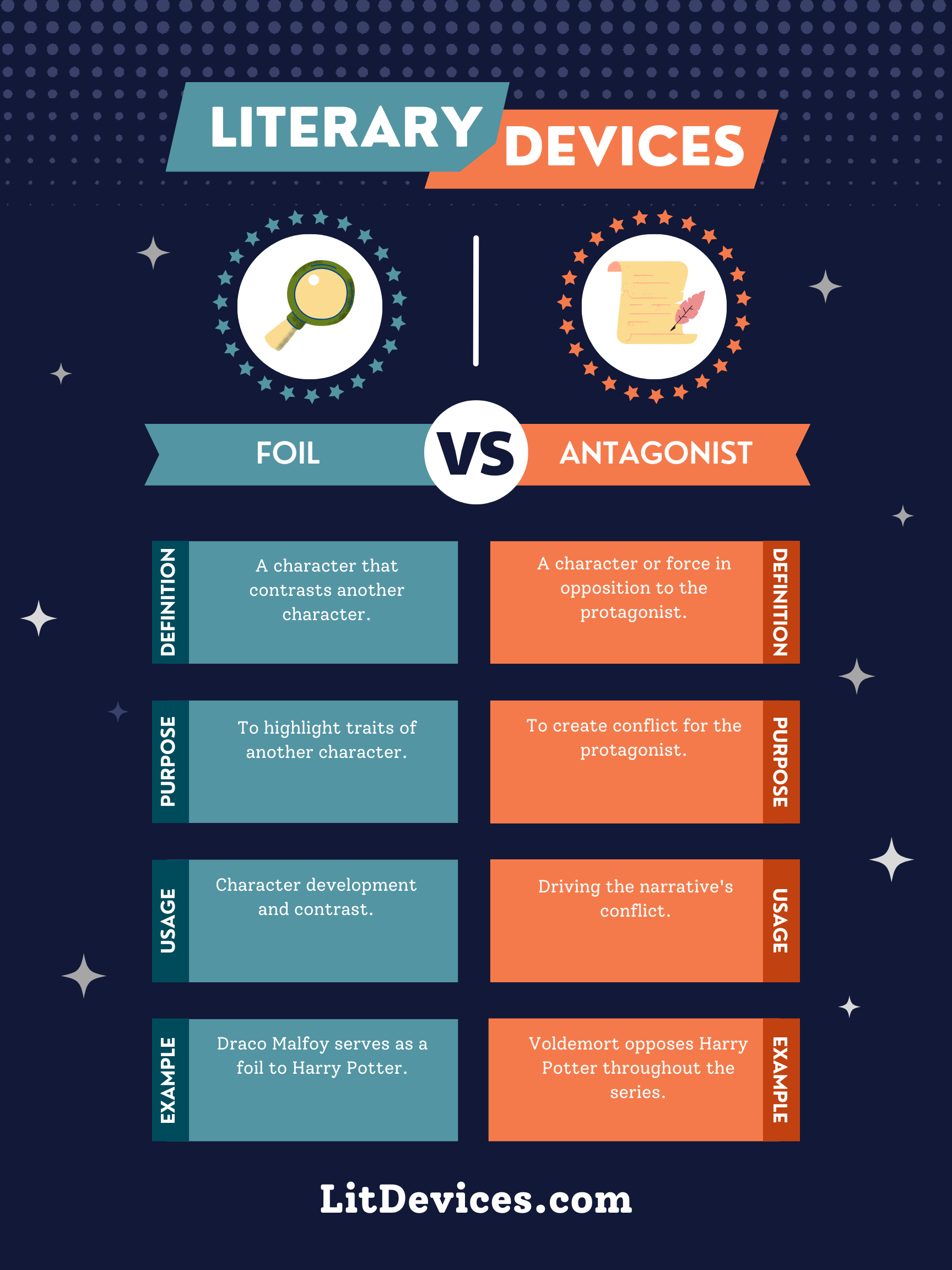Foil is a character who contrasts with another character to highlight qualities; Antagonist opposes the protagonist, often a villain.
Foil
A foil is a character in a story who contrasts with the main character, typically to highlight particular qualities of the other character. The contrast can be in personality, choices, or moral alignment, and it’s not necessarily antagonistic or negative.
🎭 Example: In “Harry Potter,” Draco Malfoy serves as a foil to Harry Potter. Their contrasting backgrounds, personalities, and choices highlight Harry’s humility, bravery, and loyalty.
Antagonist
The antagonist is a character, group of characters, or a concept that stands in opposition to the protagonist, creating conflict in the narrative. They are often thought of as the villain, but not all antagonists are evil; their goals simply conflict with those of the protagonist.
🦹 Example: In “The Lord of the Rings,” Sauron is the primary antagonist, opposing Frodo and his quest to destroy the One Ring. Sauron’s desire for power and domination contrasts with Frodo’s humility and desire for peace.
Summary
| Literary Device | Definition | Purpose | Usage | Relevant Examples |
|---|---|---|---|---|
| Foil | A character who contrasts with another character (usually the protagonist) to highlight particular qualities of the other character. | To deepen the understanding of the main character’s traits and motivations. | Used across genres in both minor and major characters to enhance character development. | Mercutio to Romeo in “Romeo and Juliet” |
| Antagonist | A character or force that opposes the protagonist, creating conflict. | To drive the narrative forward and provide obstacles for the protagonist to overcome. | Central to the plot in almost every genre, defining the story’s conflict. | Darth Vader in “Star Wars” |
Writing Tips
When crafting stories with foils or antagonists:
- For Foil: Think about what qualities you want to emphasize in your protagonist, and create a foil that contrasts sharply in those areas. Remember, a foil’s role is to highlight and not necessarily to oppose.
- For Antagonist: Your antagonist should have clear motivations and be a credible threat to the protagonist. They are the engine of conflict in your story, so give them depth and complexity to make your narrative more engaging.
🖋 Example for Foil: Consider a story about two sisters, where one is outgoing and reckless, and the other is reserved and cautious. Their contrasting personalities can help highlight each other’s growth and challenges.
🖋 Example for Antagonist: Imagine an ambitious tycoon who wants to build on a piece of land that the protagonist, an environmentalist, is trying to protect. Their conflict drives the plot, and exploring the tycoon’s reasons adds depth to the story.
FAQs
Can a character be both a foil and an antagonist?
Yes, a character can serve as both a foil and an antagonist if they both contrast and oppose the protagonist in significant ways.
Do all stories need a foil?
Not necessarily. While foils can enhance character development and thematic depth, not all stories will have or require a character that serves as a foil.
Can there be more than one antagonist or foil in a story?
Absolutely. Multiple antagonists or foils can add complexity and richness to the narrative, offering varied perspectives and challenges.
Exercise
Decide if the following characters are more likely to be a foil or an antagonist:
- A coworker who is less competent at their job, highlighting the protagonist’s expertise and work ethic.
- A villain who aims to destroy the world that the protagonist is trying to save.
- A best friend who’s always optimistic, contrasting with the protagonist’s pessimistic outlook.
- A rival detective who is also trying to solve the same case but uses unethical methods.
Answers:
- Foil
- Antagonist
- Foil
- This could be seen as both, depending on how they interact with the protagonist and the story’s focus. Typically, if their role is to highlight the protagonist’s morality or methods, they’re a foil; if they actively obstruct the protagonist, they’re an antagonist.
Interesting Literary Device Comparisons
- Static vs Dynamic Characters: Static characters do not undergo significant change over the course of a story, while dynamic characters experience

